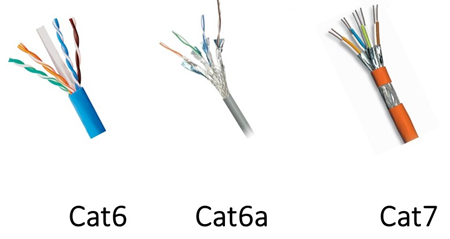
For communications and cabling manufacturers, it is easy to know the difference between several cable category (Cat 6a, Cat 6, and Cat 5e). For those looking forward to using category cables to wire a business, data center, office or home, the variances and performance ratings between these cables could be complicated. To help for a better understanding, we will examine the abilities of each cable to help you make the right choice when it comes to installations.
Category 5e Cable
Also known as category 5e, these cables support a gigabit Ethernet speed of about 1000 Mb/s at 100 MHz. Cat 5e as an advancement of the previous Cat 5 cables is almost the same with the specifications of Cat 5 cables but has an enhancement to reduce crosstalk. Cat 5e cables are best suitable for an installation that often changes, like a business and home installations where you plug patch cord connections from a computer into a wall port, servers with patch panels, etc.
Cat5e cables can come in bulk length such as cat5e plenum cable. Category 5e cables are obtainable in varying configurations such as shielded vs unshielded, as well as stranded wire vs solid copper wire variations. They are often used in a situation where there might be a great deal of EMI (Electromagnetic Interference) from other devices in an office or home environment.
Category 6 and Category 6a
In comparison to Cat 5e cables, Cat 6a and Cat 6 cables support a Gigabit Ethernet speed of about 1000 Mb/s, but the major difference between these two categories and Cat 5e is that Cat 6a and Cat 6 runs at a bandwidth of 250 MHz, makes it suitable for Cat 6a and Cat 6 to be used in a business environment. For a business or home looking forward to offering a high-performance connection, upgrading to either Cat 6a or Cat 6 can help to reduce issues with EMI and crosstalk on a network.
Cat 6a and Cat 6 offer good advantages for people looking to offer a bit of future-proofing their business or home network. The greater bandwidth that these cables possess helps to keep your network setup at a high-performance level as ISPs offer higher speeds. Due to the capability of Cat 6 to carry a higher bandwidth unlike the Cat 5e, they are ideal for a permanent installation in offices and homes. Some of the most popular cables are cat6 riser cables.
Cat 6a and Cat 6 are also obtainable in Stranded wire vs. Solid copper wire, which provides different benefits. Stranded cables use several copper wires twisted together or stranded for conductors, while solid cables comprise a single piece of copper for electrical conduction. Solid cables are perfect options for permanent installations such as outdoor and walls, where the durable feature of this cable offers flexibility and longevity, while the stranded wire is best suitable for an application where flexibility is necessary, such as areas of frequent movement including desks.
When To Use Shielded And Unshielded
A significant factor to consider between these two is the analysis of how prevailing EMI would be in an installation environment. EMI is usually caused by air conditioners, generators, nearby motors, and even office mainstays like printers and florescent lights. EMI could result to crosstalk between circuits, leading to slower transmission rates, increased errors and degradation of data. If your environment suffer from a heavy EMI, shielded cables should be the best option. An extra shielding helps to block out interference and boost reliability. A small business or home office user will barely require a shielded cable. They benefit the industrial sector mostly.
On the other hand, unshielded cables provide a faster transmission in the absence of electromagnetic interference. It is easy to install unlike the shielded cables, and less expensive.
Cat 6a As A Future-proof Solution
A significant issue that occurs when making use of Cat 6 and Cat 5e cables with 10GBASE-T application is that ANEXT (alien crosstalk) between cables becomes greatly variable, with an extra feature of insertion loss resulting in performance bottlenecks.
Whereas Cat 6a cables offer a probable alien crosstalk performance at a specified and low level, with insertion loss minimized to a manageable level.
Category 6a Supports Emergency Transfer
When it comes to transferring large data files containing graphics and videos, we need a bandwidth-intensive application at a speed of 100Mb/s to 1000Mb/s. If your system uses Cat 6 or Cat 5e, these translations may create a big load on them, whereas, with Cat 6a cables, it can be done easily as they can offer bandwidth up to 10Gb/s.
Other future-proofing advantage is that they support a high-speed data transfer and are also shielded to prevent crosswalks.
Conclusion
Considering the increasing demands of our digital landscape, it is not difficult to imagine a future five to ten years from now, where Category 6a infrastructure is not only useful in a bottom line of a business, but also relevant.
May is Small Business Month, a time to honor and recognize the achievements of the… Read More
Swiss International University (SIU) is on track to be one of the world's most respected… Read More
In a session that left students buzzing with fresh ideas and practical insights, Invertis University… Read More
At the 21st Shanghai International Automobile Industry Exhibition, which is surging with the wave of… Read More
Liverpool, UK—House of Spells and Comic Con Liverpool are once again collaborating to bring the… Read More
Introduction In India's booming EdTech space, there's one name that's making waves among Telugu students… Read More